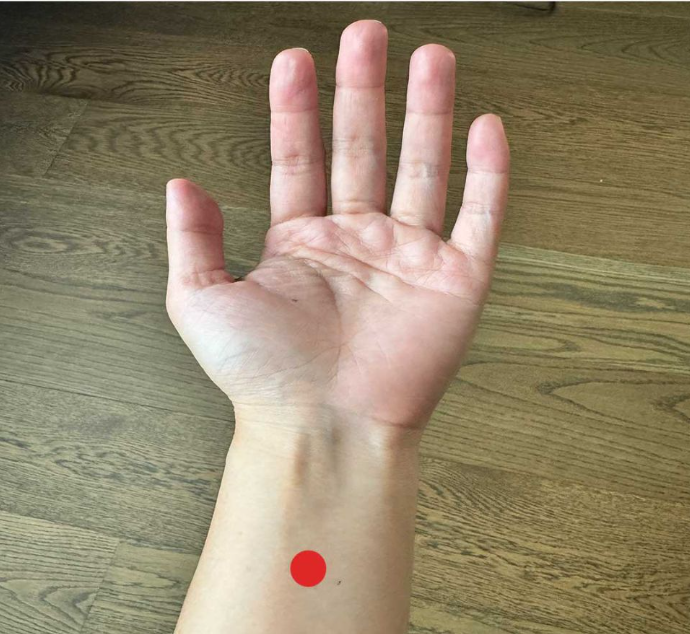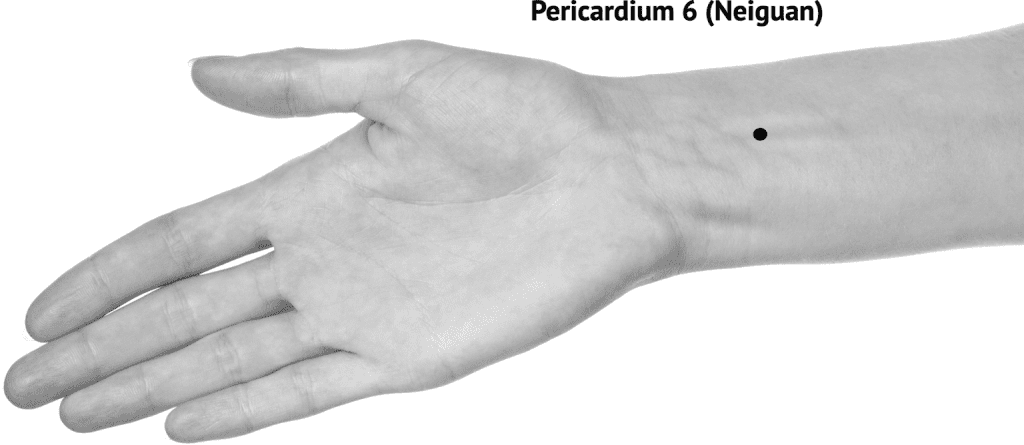Many ancient healing practices have been passed down through generations, one of which is acupressure, a technique rooted in Traditional Chinese Medicine (TCM). Among the numerous points used in acupressure, the Nei Guan point (Pericardium 6) stands out due to its profound impact on various ailments. From alleviating nausea to reducing anxiety, this specific point has garnered significant attention for its healing capabilities. This article will delve into how pressing this point on your wrist can affect your body, uncovering both the traditional and modern benefits of stimulating the Nei Guan point.

What is the Nei Guan Point?
The Nei Guan point, also known as Pericardium 6 (P6) in acupuncture terminology, is a specific acupressure point located on the inner wrist. It’s situated about two to three finger-widths above the wrist crease, nestled between the two tendons of the palmaris longus and flexor carpi radialis muscles. This point is highly regarded in TCM for its ability to regulate heart health, calm the mind, and treat digestive issues.
To locate it, simply curl your fingers toward your palm, find the wrist crease, and measure three fingers up from it. Once you’ve found the spot between the two tendons, you’ve located the Nei Guan point.
Historical Significance and Traditional Uses of the Nei Guan Point
In ancient times, Chinese healers believed that each acupressure point was a gateway to the body’s energy, or Qi. The Nei Guan point was thought to be directly connected to the Pericardium meridian, responsible for protecting the heart. By stimulating this point, practitioners believed they could soothe the spirit, relieve tension in the chest, and promote overall well-being.
For centuries, it was used to address a range of issues such as nausea, heart palpitations, and insomnia. Over time, its benefits were recognized beyond Chinese medicine, and today, it’s incorporated into modern holistic health practices worldwide.
How Does Stimulating the Nei Guan Point Affect Your Body?
Modern research has started to explore the physiological effects of pressing the Nei Guan point, particularly in relation to its traditional uses. Pressing this point is thought to help balance the body’s energy, clear blockages in the Qi flow, and promote overall harmony in the body.
But what happens on a biological level when you apply pressure to the Nei Guan point? Here are some of its key effects:
1. Relief from Nausea and Vomiting
One of the most widely recognized benefits of stimulating the Nei Guan point is its ability to relieve nausea and vomiting. Whether it’s caused by motion sickness, pregnancy-related morning sickness, or the side effects of chemotherapy, pressing this point has been shown to alleviate symptoms. It is believed to work by stimulating the vagus nerve, which helps regulate the digestive system and reduce nausea signals.

2. Calming the Nervous System and Reducing Anxiety
When you press the Nei Guan point, it can have a calming effect on your nervous system. This acupressure point is frequently used to combat stress, anxiety, and nervous tension. By reducing the body’s sympathetic nervous activity, it can promote a state of relaxation and tranquility.
If you’re feeling overwhelmed or anxious, a few minutes of pressure on the Nei Guan point can help restore your sense of calm.
3. Supporting Heart Health and Circulation
Linked to the Pericardium meridian, the Nei Guan point plays an important role in supporting heart health. Acupressure at this point may improve blood circulation and help maintain normal heart rhythms. Some practitioners believe it can help regulate blood pressure and provide relief from heart palpitations. Though research is still evolving, the connection between this point and cardiovascular wellness is an exciting area of exploration.
4. Alleviating Headaches and Migraines
Another common use of the Nei Guan point is for alleviating headaches and migraines. By stimulating blood flow and promoting relaxation, acupressure at this point can help relieve the tension that often accompanies chronic headaches. Additionally, its calming effects on the nervous system may reduce stress-related headaches.

5. Enhancing Digestive Health
Pressing the Nei Guan point is also believed to promote digestive health. By encouraging better gut motility and regulating gastric functions, it can alleviate discomfort caused by indigestion, bloating, and constipation. When your stomach feels upset or out of balance, stimulating this acupressure point may offer relief by helping your digestive system work more efficiently.
Scientific Evidence: Does Pressing the Nei Guan Point Really Work?
Scientific studies are beginning to validate some of the traditional claims regarding the Nei Guan point. One area of research that shows promising results is in the treatment of nausea. Clinical studies have found that stimulating this point can effectively reduce postoperative nausea, chemotherapy-induced nausea, and morning sickness in pregnant women.
Additionally, early research on the cardiovascular benefits of the Nei Guan point suggests that it can help reduce heart rate variability and lower blood pressure, although more research is needed to confirm these effects.
How to Apply Pressure to the Nei Guan Point: A Simple Guide
If you’re curious about trying this acupressure technique for yourself, follow these simple steps to apply pressure to the Nei Guan point:
- Locate the Point: Find the inner side of your wrist and measure three finger-widths up from the wrist crease. The point lies between the two prominent tendons.
- Apply Gentle Pressure: Using your thumb, apply firm but gentle pressure to the point. Make small circular motions as you press, and focus on breathing deeply to enhance the relaxation effect.
- Duration: Hold the pressure for about one to two minutes on each wrist. You can repeat this throughout the day as needed, but avoid overapplying or using too much force.
- Relax and Breathe: While applying pressure, take slow, deep breaths. This helps to calm the nervous system and maximize the effects of the acupressure.

Precautions to Keep in Mind
While stimulating the Nei Guan point is generally considered safe, there are a few precautions to keep in mind. Avoid applying pressure to this point if you have any wrist injuries or conditions that could worsen with pressure. Additionally, individuals with certain heart conditions or who are pregnant should consult a healthcare professional before attempting acupressure.
Conclusion: Unlocking the Healing Power of the Nei Guan Point
Incorporating acupressure into your daily wellness routine can offer a natural and holistic approach to managing stress, nausea, and even cardiovascular health. The Nei Guan point (Pericardium 6) stands out as one of the most versatile points in Traditional Chinese Medicine, offering a range of benefits from calming the mind to improving digestion. Whether you’re battling nausea, anxiety, or simply looking to enhance your well-being, pressing this point on your wrist might be the simple, non-invasive solution you’ve been seeking.


